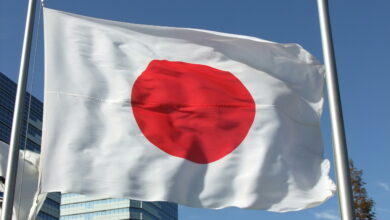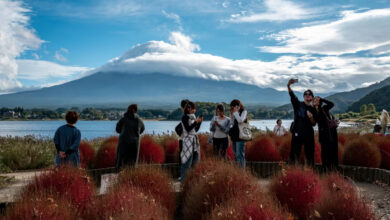
Huge landslides in western Japan killed at least 32 people and left another nine missing Wednesday, authorities said, after waves of mud engulfed homes in a suffocating sludge.
Dozens of houses were buried when hillsides collapsed after torrential downpours in Hiroshima, television pictures showed, leaving rescuers to pick through the devastation for any signs of life.
A spokesman for Hiroshima Police told AFP the death toll was still climbing.
"The figures may change as the rescue efforts continue," he warned.
The number of dead had risen rapidly from an initial four, which included a two-year-old boy.
Among the dead was a 53-year-old rescuer, who was killed by a secondary landslide after he had pulled five people to safety, the Fire and Disaster Management Agency said.
Aerial footage showed several houses buried in thick slurry, their wooden frames splintered by the weight of the mud.
Torrents of brown water raced off the mountains behind the homes and through the wrecked buildings, hampering rescuers' efforts as they searched for anyone still trapped.
Emergency workers were seen climbing up to the second floor and roofs of half-collapsed houses — some of which were floating — to try to reach any survivors.
Pictures showed there had been at least five different landslides. Some uprooted trees and carried rocks down the hillside into the tightly-packed houses that sit on the edge of a commuter belt, in an area where town gives way to farmland.
One man, gesturing to the mud-covered remains of a house, told NHK: "My house is over there, flattened."
Pointing elsewhere, he said: "A leg was seen (sticking out of the mud) and they are trying to confirm if the person is alive. The first thing we have to do is to help that person."
Another man told reporters he had seen everything he owned swept away.
"We could hear the earth rumbling and all of a sudden, things roared past us," he said.
A woman spoke of how she had escaped death because of where she had been at the time the disaster struck.
"I was able to survive as I stayed in the middle of the house. Both sides were destroyed."
– Troops deployed –
Troops were deployed to help in the rescue after a request from the local government.
Prime Minister Shinzo Abe, who abandoned a golfing holiday to deal with the disaster, said considerable resources were pressed into action.
"I have ordered (government officials) to carry out the rescue operation in an integrated manner, aware of the possibility of further rain," he told reporters in Tokyo.
"I also ordered them to raise the number of Self-Defense Force (military) personnel to several hundred in order to strengthen rescue operations," he said.
Japan's weather agency warned more heavy rain was on the way to the area, raising the risk of further landslides in places where tonnes of mud have already been displaced.
The archipelago has been battered in recent weeks by unusually heavy rain that has sparked a number of smaller landslides and several floods, some of which have proved fatal.
Despite widespread concreting to shore up hillsides, mountainous and densely populated Japan is prone to this kind of disaster.
In October last year, dozens of people were killed when the torrential rains of a passing typhoon triggered large landslides on the island of Oshima, south of Tokyo.
Hiroshima is no stranger to tragedy like this.
In 1999 more than 320 landslides hit the city, including the area affected on Wednesday, killing more than 30 people.
Around 32,000 places in the locality are designated as at risk from landslides.
Experts said many of the hills are composed of fragmented granite, which can become unstable when waterlogged.




